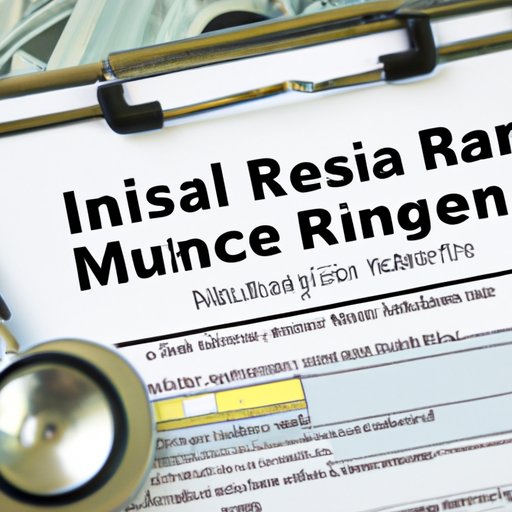Introduction
Magnetic resonance imaging (MRI) is a diagnostic tool used to create detailed images of the inside of the body. MRIs are often used to diagnose and monitor conditions such as cancer, heart disease, stroke, and neurological disorders. While MRIs can be invaluable in helping to diagnose and treat medical conditions, they can also be expensive, especially if you don’t have health insurance. In this article, we’ll explore how much an MRI costs with insurance coverage and what you need to know about navigating your insurance plan.
Exploring the Cost of an MRI with Insurance Coverage
Your health insurance policy can have a significant impact on the cost of an MRI. Insurance plans vary in terms of what they cover, so it’s important to understand the details of your particular plan. Generally speaking, most insurance plans will cover some or all of the cost of an MRI, depending on the type of coverage you have.
There are two main types of coverage that can affect the cost of an MRI: deductibles and co-pays. A deductible is an amount of money that you must pay out of pocket before your insurance plan kicks in. A co-pay is a fixed amount of money that you must pay for each visit or procedure. Depending on your plan, you may have to pay both a deductible and a co-pay for an MRI.
How Much Does it Cost to Get an MRI if You Have Insurance?
The cost of an MRI with insurance coverage can vary greatly depending on several factors. On average, an MRI can cost anywhere from $400 to $3,000, with insurance covering some or all of the cost. The type of scan and facility where the MRI is performed can also play a role in determining the cost.
For example, a standard MRI of the brain may cost between $400 and $1,200, while an MRI of the spine can cost anywhere from $600 to $2,000. An MRI at an outpatient center is usually less expensive than an MRI in a hospital setting.
The Cost of an MRI: What to Expect With Insurance
When it comes to understanding the cost of an MRI with insurance coverage, it’s important to understand the details of your particular plan. Different insurance plans have different levels of coverage, so it’s essential to familiarize yourself with your plan’s coverage and any associated costs. It’s also important to note that some insurance plans may not cover MRIs at all.
In addition, it’s important to consider whether the provider you’re using is “in-network” or “out-of-network.” In-network providers are those who have agreed to accept the rates set by your insurance company, while out-of-network providers can charge higher rates. In general, using an in-network provider can help to reduce the cost of an MRI.

MRI Costs: What You Need to Know About Insurance Coverage
When it comes to the cost of an MRI with insurance coverage, it’s important to understand the details of your particular plan. Your plan may include a deductible, which is an amount of money that you must pay out of pocket before your insurance coverage kicks in. Your plan may also include a co-pay, which is a fixed amount of money that you must pay for each visit or procedure.
In addition, your plan may also cover some or all of the cost of an MRI. It’s important to note that in-network providers usually offer lower rates than out-of-network providers, so it’s best to use an in-network provider when possible.

Save Money on MRIs: Understanding Your Insurance Plan
Understanding your insurance plan is key to saving money on MRIs. It’s important to familiarize yourself with your plan’s coverage and any associated costs. It’s also important to consider whether the provider you’re using is “in-network” or “out-of-network.” In general, using an in-network provider can help to reduce the cost of an MRI.
In addition, there are other strategies you can use to save money on an MRI. For example, some insurance companies offer discounts for MRIs performed at certain facilities. Additionally, many hospitals and imaging centers offer payment plans that allow you to spread the cost of an MRI over several months.

An Overview of MRI Costs and Insurance Coverage
Navigating the cost of an MRI can be confusing, especially if you don’t have insurance coverage. However, understanding the details of your insurance plan can help to reduce the cost of an MRI. Additionally, there are other options available for those without insurance, such as payment plans and discounted rates.
Ultimately, it’s important to understand the cost of an MRI and the various ways you can maximize your insurance coverage or minimize the cost. By doing your research and understanding your options, you can ensure that you get the care you need without breaking the bank.
Conclusion
MRIs can be a valuable tool for diagnosing and treating medical conditions, but they can also be expensive. Fortunately, insurance plans can help to reduce the cost of an MRI. It’s important to understand the details of your particular plan, including deductibles, co-pays, and in-network versus out-of-network providers. Additionally, there are other strategies you can use to reduce the cost of an MRI, such as payment plans and discounted rates.
For more information on MRI costs and insurance coverage, contact your insurance provider or speak with your doctor. They can provide you with additional resources and advice on how to make the most of your insurance coverage.
(Note: Is this article not meeting your expectations? Do you have knowledge or insights to share? Unlock new opportunities and expand your reach by joining our authors team. Click Registration to join us and share your expertise with our readers.)
